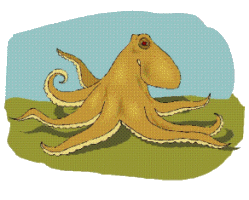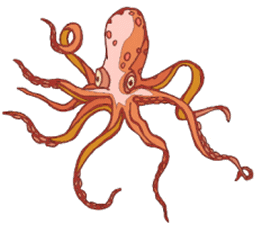Octopus
|
Phylum
|
Mollusca
|
|
Class
|
Cephalopoda
|
|
Genus & Species
|
Octopus vulgaris
|
|
Length
|
Up to 10 feet, but usually smaller
|
|
Weight
|
Up to 55 pounds.
Females are mature at
2 pounds
Males are mature at 3 1/2 pounds
|
|
Sexual maturity
|
Females, 1 1/2 to 2 years. Males
earlier
|
|
Number of eggs laid
|
Up to 150,000
|
|
Hatching time
|
4 to 6 weeks
|
|
Habit
|
Solitary, bottom-dwelling
|
|
Diet
|
Mainly crabs, crayfish, and bivalves
|
|
Lifespan
|
Females usually die after breeding at
about 2 years of age; males live longer
|
A bottom-dwelling animal, the octopus makes its home in a
hole or rock crevice in shallow water. Sometimes it
digs a gravel
nest or forms a protective area with a pile of rocks. By day, the
octopus spends most of its
time hidden in its lair. When it hunts,
if propels itself by swimming or crawling along on its tentacles.
Its
large, lidded eyes are adapted to focus in dim underwater light.

The octopus does most of its hunting at night. It emerges from it
rocky lair to seek crabs, crayfish, and mollusks,
which are its
favorite foods. The octopus catches most of its prey by stealth.
Having changed color to blend in
with its surroundings, the
well-camouflaged octopus waits for prey to pass by and then seizes
it with its long arms.
The arms are powerful and flexible, with
two rows of suckers that help it grip its slippery prey. The octopus
then
stuns its victim with a secretion of nerve poison. To stalk
lobsters and other dangerous prey, the octopus squirts
ink into the water to form a screen. Hiding behind the dark cloud, it creeps up
on its victim and grabs it from
behind. If the octopus's prey is
hard-shelled, the octopus punctures the shell by drilling with its
tongue, which is
covered in small, sharp teeth.
The
octopus's predators include moray and conger eels, dolphins, and
sharks. Whenever possible, the octopus will escape
from its
predators by shooting a jet of water through its body to create
a burst of speed. Often, however, the octopus
avoids detection
completely. It can change its body color and texture so perfectly
that it can virtually disappear. The
colored pigment in its skin
can be concentrated or diluted, forming stripes and patterns that
blend into the environment.
The octopus's ink sac also helps it
avoid attack. It releases a disorienting black cloud that is
accompanied by another
secretion to dull the attacker's sense of
smell.

When octopuses mate, the male sends waves of spermatophores down one of its arms---the hectocotylus---into the female to
fertilize her eggs. For about a week afterward, the female lays clusters of grapelike eggs inside her nest. She will not
leave her nest in the month to 6 weeks that it takes for the eggs to hatch. Because female octopuses do not eat while they
are guarding their eggs, it is not uncommon for them to die of starvation. The eggs hatch into larvae that look like tiny
versions of their parents. They come to rest on the seabed, where they mature quickly.
| DID YOU KNOW? |
The first writing ink was made from pigment
found in the octopus's sac |
The octopus is messy. It is easy to identify its lair by
the pile of discarded shells outside the entrance |
If an octopus damages on of its vital arms,
it can grow a new one |
The octopus is capable of learning. In an experiment,
octopuses were trained to distinguish between shapes and also
to recognize
objects by touch |
Information is Copyright IMP BV/IMP Inc. Wildlife Fact File
| Great
White Shark | Sea Otter |
| Sea Horse | Blue Whale
|
| Octopus | Bottlenose
Dolphin |
| Sperm Whale | California
Sea Lion |
| Elephant Seal | Adopt An
Animal |

| Home |
| Michele |
Links |
Sign Language |
| Adoptions |
Animals
| Say No To Drugs |
| Holidays | History |
|
All graphics and
pages are copyright © 1997 - 2008 Pages 4 Ever
(except where noted). Do not take, copy, steal, plagiarize or use in any
way, shape or format without the express written permission of Pages
4 Ever.
Some backgrounds and graphics made from clipart acquired from ArtToday, Boxed Art,
friends, my own imagination, and/or
graphic CD collections that I have purchased. If you find anything on this site
that you have copyright to, and can prove it, please let me know and I will
gladly either remove it or place a link back to you, whichever you prefer.
If you should find any broken links, please drop us a line and let us know the
exact URL the broken link is on. Thank you.
|

|